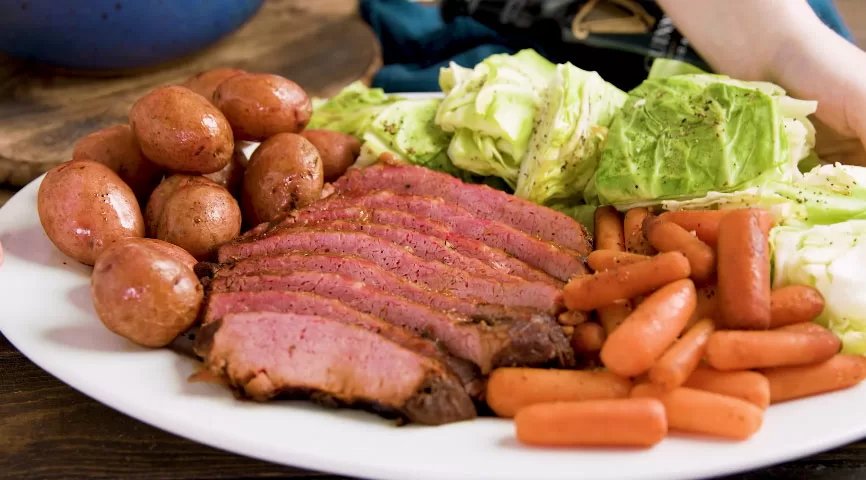Get ready to celebrate St. Patrick’s Day in delicious style with a classic Corned Beef and Cabbage recipe! Whether you’re Irish or just Irish at heart, this iconic meal is sure to please both your taste buds and your festive spirit. So grab your cooking apron and let us focus into the world of Corned Beef and Cabbage!
Intro
St. Patrick’s Day is a time-honored tradition that celebrates Irish culture and heritage around the world. From parades to parties, this festive holiday brings people together in the spirit of merriment and cheer. And what better way to mark the occasion than with a mouthwatering Corned Beef and Cabbage feast?
This classic dish has become synonymous with St. Patrick’s Day, offering a hearty blend of flavors and textures that satisfy both body and soul. The tender, succulent beef paired with savory cabbage, potatoes, and carrots creates a comforting meal that warms you from the inside out.
Whether you’re hosting a celebration or simply craving some traditional Irish fare, Corned Beef and Cabbage is sure to hit the spot. So roll up your sleeves, gather your ingredients, and get ready to cook up a taste of Ireland right in your own kitchen!
St Patrick’s Day
St. Patrick’s Day is a vibrant and festive celebration that brings people together to honor Irish culture and heritage. It’s a day filled with parades, lively music, traditional dances, and of course, delicious food. From wearing green attire to enjoying a pint of Guinness, everyone joins in the fun on this special day.

St. Patrick’s Day is celebrated on March 17th.
The holiday commemorates Saint Patrick, the patron saint of Ireland, who brought Christianity to the country during the 5th century. Over time, St. Patrick’s Day has evolved into a global celebration of Irish pride and identity.
Whether you have Irish roots or not, St. Patrick’s Day is an opportunity to embrace the spirit of unity and camaraderie with friends and family. So don your greenest outfit, raise a glass to good cheer, and revel in the joyous festivities that make this day so memorable for all who partake in it!
What is corned beef?
Corned beef is a popular dish often associated with St. Patrick’s Day celebrations, but what exactly is it? Well, contrary to its name, corned beef has nothing to do with corn. In fact, the term “corned” refers to the large grains of salt historically used to cure the meat.
This type of beef comes from the brisket cut and undergoes a curing process where it’s soaked in brine with various seasonings like peppercorns, mustard seeds, and bay leaves. The result? A flavorful and tender meat that pairs perfectly with cabbage and potatoes.
The distinctive pink color of corned beef comes from nitrites used in the curing process. While some may opt for store-bought versions, making your own allows you to control the ingredients and flavors added to suit your taste preferences. So next time you enjoy this classic dish on St. Patrick’s Day or any other occasion – remember its unique history!
Corned Beef And Cabbage Recipe for St Patrick’s Day
Corned beef is essentially salt-cured beef brisket, giving it a unique flavor profile that pairs perfectly with the earthiness of cabbage. The cooking process involves simmering the meat until tender along with spices like peppercorns, mustard seeds, and bay leaves to enhance its taste.
Ingredients needed
When it comes to making a delicious Corned Beef and Cabbage dish, the key lies in selecting the perfect ingredients. For this classic recipe, you will need a piece of corned beef brisket, cabbage, carrots, potatoes, onions, and some flavorful spices.
Start by choosing a high-quality corned beef brisket – make sure it’s well-marbled for maximum tenderness and flavor. Then gather fresh cabbage heads; remember to remove the tough outer leaves before chopping them into wedges. Don’t forget about adding carrots for sweetness and color.
For added depth of flavor, include some peeled potatoes and onions in your ingredient list. These vegetables complement the savory meat perfectly. Pick up some whole black peppercorns, bay leaves, mustard seeds or powder – these will elevate the taste profile of your dish.
With these essential ingredients on hand, you’re all set to create a mouthwatering Corned Beef and Cabbage meal that will impress your family or guests!
Instructions for making
Once you have gathered all the ingredients for your delicious Corned Beef and Cabbage, it’s time to start cooking!
Start by placing the corned beef in a large pot and covering it with water. Bring the water to a boil, then reduce the heat and let it simmer for about 2 hours until the meat is tender.
Next, add in your chopped carrots, potatoes, and cabbage to the pot. Let everything cook together for another 30 minutes or until the fresh vegetables are soft.
Once everything is cooked through, carefully remove the corned beef from the pot and slice it thinly against the grain. Serve the slices of corned beef alongside a generous helping of vegetables on a platter.

Don’t forget to spoon some of that flavorful cooking liquid over everything for an extra burst of flavor. Enjoy your homemade Corned Beef and Cabbage with your family and friends!
When serving corned beef, make sure to slice it against the grain for maximum tenderness. Pair it with boiled cabbage, carrots, and potatoes for a hearty meal that will surely satisfy your cravings.
How can I use leftover corned Beef?
Leftover corned beef can be repurposed in delicious ways to avoid food waste. One option is to use it in a classic Reuben sandwich, layered with sauerkraut, Swiss cheese, and Russian dressing on rye bread. Another idea is to chop up the corned beef and add it to a hearty potato hash for a flavorful breakfast or brunch dish.
You can also incorporate leftover corned beef into a savory pot pie filling by combining it with vegetables like carrots, peas, and potatoes before topping with puff pastry. For a quick lunch or dinner option, consider making corned beef tacos by shredding the meat and serving it in warm tortillas with avocado slices and salsa.
If you’re looking for a lighter meal, toss chopped leftover corned beef into a salad along with greens, cherry tomatoes, and your favorite dressing. The possibilities are endless when it comes to using up leftover corned beef!
How Should I Serve Corned Beef?
When it comes to serving corned beef, there are a variety of delicious options to consider. One classic way is to slice the corned beef thinly against the grain and serve it alongside some tender cabbage cooked in the flavorful broth. The combination of savory meat and hearty vegetables is sure to satisfy your taste buds.

Another popular serving suggestion is to pile the sliced corned beef onto a sandwich with some tangy mustard or creamy horseradish sauce for an extra kick. This makes for a tasty lunch option that’s easy to prepare and oh-so-satisfying.
If you’re feeling more creative, you can incorporate leftover corned beef into dishes like hash, tacos, or even fried rice for a unique twist on traditional recipes. The possibilities are endless when it comes to serving up this versatile and flavorful meat.
Is Corned Beef really Irish?
Is Corned Beef really Irish? This question often sparks debate among food enthusiasts. While corned beef is commonly associated with Irish cuisine, its origins actually trace back to Jewish and Eastern European traditions.
During the 17th century in Ireland, beef was a luxury item for many households due to the high cost. It wasn’t until Irish immigrants settled in America that corned beef became more widely popularized. In the United States, it became a staple dish associated with St Patrick’s Day celebrations.

The process of corning meat by curing it in a brine solution with salt and various spices can be found across different cultures worldwide. However, the specific pairing of corned beef and cabbage as an iconic Irish dish may have more American roots than traditionally Irish ones.
Whether or not corned beef is authentically Irish depends on one’s perspective and interpretation of culinary history.
What is Corned Beef seasoning made of?
Corned beef seasoning is a blend of spices that gives this classic dish its signature flavor. The key ingredients typically include whole peppercorns, mustard seeds, coriander seeds, bay leaves, and sometimes cloves or allspice. These spices work together to create a savory and aromatic profile that enhances the richness of the beef.
The peppercorns add a subtle heat while the mustard seeds provide a hint of tanginess. Coriander seeds contribute earthy notes, complemented by the fragrant essence of bay leaves. Cloves or allspice can bring warm undertones to the mix, rounding out the complex flavors in corned beef seasoning.
By infusing these spices into the cooking liquid during preparation, they penetrate deep into the meat as it simmers slowly to tender perfection. This infusion process allows for a depth of flavor that makes corned beef such a beloved St Patrick’s Day staple.
Tips for a perfect tender corned beef
When it comes to making a tender corned beef, there are a few tips that can make all the difference in your St. Patrick’s Day meal.
Choose the right cut of meat. Opt for a brisket cut with marbling throughout for added tenderness and flavor.
Don’t rush the cooking process. Corned beef thrives on low and slow cooking methods like simmering or braising.

Adding aromatics such as onions, garlic, and spices to the cooking liquid can enhance the overall flavor profile of your corned beef.
Consider using a pressure cooker if you’re short on time but still want that melt-in-your-mouth texture.
Allow your cooked corned beef to rest before slicing against the grain for maximum tenderness in every bite.
Helpful tips from our team
When preparing your Corned Beef And Cabbage for St. Patrick’s Day, there are some helpful tips to keep in mind. First, make sure to rinse the corned beef before cooking to remove excess saltiness. This step can help balance the flavors and prevent it from being too salty.
Another tip is to cook the corned beef low and slow for a tender result. Using a slow cooker or simmering on the stovetop can help achieve that melt-in-your-mouth texture that everyone loves.
Adding aromatics like onions, garlic, and spices while cooking can enhance the flavor profile of your dish. These ingredients infuse their essence into the meat during cooking, creating a rich and flavorful outcome.
Don’t forget to let your corned beef rest before slicing it. Allowing it to rest helps redistribute the juices throughout the meat, ensuring each bite is juicy and delicious.
Conclusion
As we wrap up our exploration of corned beef and cabbage recipes for St. Patrick’s Day, it’s clear that this traditional dish holds a special place in many households during this festive time of year. From the rich flavors of the tender corned beef to the hearty texture of the cabbage, there’s something comforting about enjoying this meal with loved ones.
Whether you’re a seasoned chef or just starting out in the kitchen, trying your hand at making corned beef and cabbage can be a fun culinary adventure. Don’t be afraid to experiment with different seasonings or cooking methods to make this dish your own.
Remember, St. Patrick’s Day is not just about food but also about celebrating Irish culture and heritage. So as you gather around the table to enjoy your delicious corned beef and cabbage, take a moment to appreciate the traditions and history behind this iconic dish.
So here’s to good food, good company, and a bit o’ luck – may your St. Patrick’s Day be filled with joy and plenty of tasty treats!
You also love to hear:
